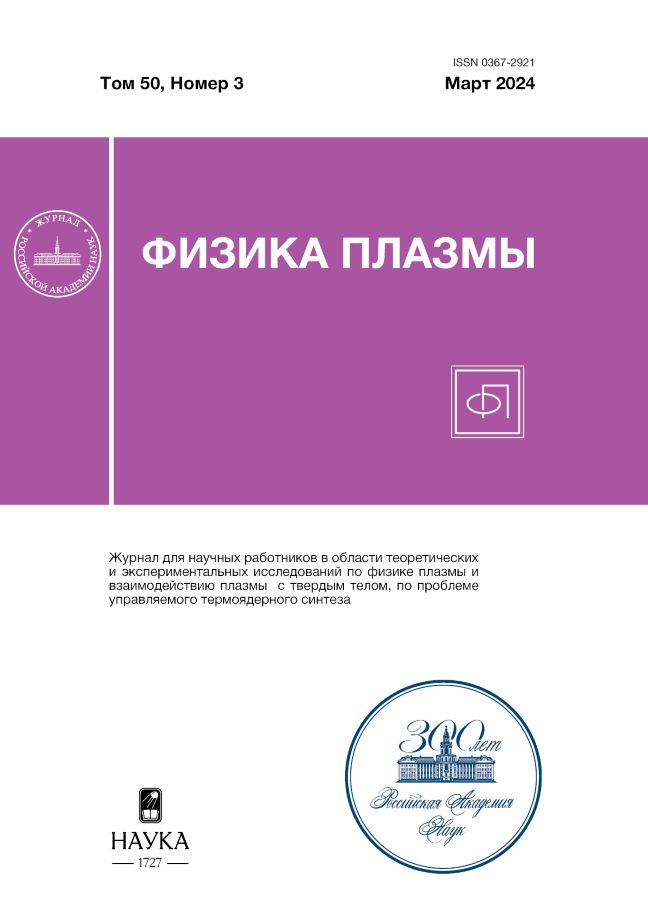Deposition of thin refractory-metal-films onto glasses through diaphragms at plasma focus facility
- Authors: Kolokoltsev V.N.1, Nikulin V.Y.2, Silin P.V.2, Borovitskaya I.V.1, Peregudova E.N.2, Gaidar A.I.3, Kobeleva L.I.1, Mezrin A.M.4, Eriskin A.A.2
-
Affiliations:
- Baikov Institute of Metallurgy and Materials Science, Russian Academy of Sciences
- Lebedev Physical Institute, Russian Academy of Sciences
- Institute of Advanced Materials and Technologies
- Ishlinsky Institute for Problems in Mechanics, Russian Academy of Sciences
- Issue: Vol 50, No 3 (2024)
- Pages: 306-314
- Section: INTERACTION OF PLASMA WITH SURFACES
- URL: https://archivog.com/0367-2921/article/view/668869
- DOI: https://doi.org/10.31857/S0367292124030055
- EDN: https://elibrary.ru/RGFLJG
- ID: 668869
Cite item
Abstract
The results of experiments are presented on the deposition onto silicate glasses of thin refractorymetal- films: molybdenum, tantalum and tungsten. The technique used for manufacturing films was based on the deposition of metal-containing plasma formed when exposing the surface of foils made of refractory metals to high-power plasma and ion pulses. For generation of such pulses, the facility of plasma focus type was used, which makes it possible to obtain ion beams and plasma flows with the energy flux density in the range of 1010—1012 W/cm2. The most intense central part of the ion-plasma flow was separated using metal diaphragms with aperture diameters of 2.5, 3.5, and 4.5 mm. Metal Mo, Ta and W films with dimensions of ∅ 3—5 mm were obtained on the surfaces of glasses. Metal films are characterized by good adhesion, since they coalesce with the glass surface. It was discovered that the planarity of films becomes violated due to the drift of molten metal particles under the glass surface. The relief of films is non-uniform, which can be explained by the presence of micrometer-sized metal particles in the plasma flow.
Full Text
About the authors
V. N. Kolokoltsev
Baikov Institute of Metallurgy and Materials Science, Russian Academy of Sciences
Author for correspondence.
Email: v.kolokoltsev@yandex.ru
Russian Federation, Moscow
V. Ya. Nikulin
Lebedev Physical Institute, Russian Academy of Sciences
Email: nikulinvy@lebedev.ru
Russian Federation, Moscow
P. V. Silin
Lebedev Physical Institute, Russian Academy of Sciences
Email: v.kolokoltsev@yandex.ru
Russian Federation, Moscow
I. V. Borovitskaya
Baikov Institute of Metallurgy and Materials Science, Russian Academy of Sciences
Email: v.kolokoltsev@yandex.ru
Russian Federation, Moscow
E. N. Peregudova
Lebedev Physical Institute, Russian Academy of Sciences
Email: v.kolokoltsev@yandex.ru
Russian Federation, Moscow
A. I. Gaidar
Institute of Advanced Materials and Technologies
Email: v.kolokoltsev@yandex.ru
Russian Federation, Moscow
L. I. Kobeleva
Baikov Institute of Metallurgy and Materials Science, Russian Academy of Sciences
Email: v.kolokoltsev@yandex.ru
Russian Federation, Moscow
A. M. Mezrin
Ishlinsky Institute for Problems in Mechanics, Russian Academy of Sciences
Email: v.kolokoltsev@yandex.ru
Russian Federation, Moscow
A. A. Eriskin
Lebedev Physical Institute, Russian Academy of Sciences
Email: v.kolokoltsev@yandex.ru
Russian Federation, Moscow
References
- Бушминский И. П., Морозов Г. В. Технологическое проектирование микросхем СВЧ. М.: МГТУ, 2001.
- Chalapathy R. B.V., Ramakrishna Reddy K. T. // Adv. Mater. Sci. Technol. 1998. V. 1. P. 1.
- Технология тонких пленок. Справ. Т. 1 / Ред. Л. Майселл, Р. Глэнг. М.: Советское радио, 1977. С. 664.
- Пичугин В. Ф. Материаловедение поверхности и тонких пленок. Томск: ТПУ, 2008. С. 173.
- Родунер Э. Размерные эффекты в наноматериалах. М.: Техносфера, С. 352.
- Палатник Л. С. Материаловедение в микроэлектронике. М.: Энергия, 1977. С. 280.
- Епифанов Г. И., Мома Ю. А. Физические основы конструирования и технология РЭА и ЭВА. М.: Советское радио, 1979. С. 352.
- Технология тонких пленок. Справ. Т. 2 / Ред. Л. Майселл, Р. Глэнг. М.: Советское радио, 1977. С. 768.
- Behrisch R. Sputtering by Particle bombardment: Experiments and Computer Calculations from Threshold to MeV Energies. Berlin: Springer, 2007.
- Данилин Б. С. Применение низкотемпературной плазмы для нанесения тонких пленок. М.: Энергоатомиздат, 1989. С. 328.
- Polukhin S. N., Nikulin V. Ya., Silin P. V. // Plasma Phys. Rep. 2022. V. 48. P. 346. https://doi.org/10.1134/S1063780X22040110
- Nikulin V. Ya., Kolokoltsev V. N., Silin P. V., Polu-khin S. N. // Bull. Lebedev Phys. Inst. 2019. V. 46. P. 360. https://doi.org/10.3103/S1068335619110083
- Bondarenko G. G., Borovitskaya I. V., Pimenov V. N., Gribkov V. A., Paduch M., Gaidar A. I., Paramonova V. V., Morozov E. V. // Russ. Metall. 2017. P. 928. https://doi.org/10.1134/S0036029517110064
- Kolokoltsev V. N., Maslyaev S. A., Borovitskaya I. V., Nikulin V. Ya., Silin P. V. Peregudova E. N. // J. Phys.: Confer. Ser. 2020. V. 1647. P. 012017. https://doi.org/10.1088/1742-6596/1647/1/012017
- Физические величины. Справ. М.: Энергоатомиздат, 1991. C. 289.
Supplementary files























